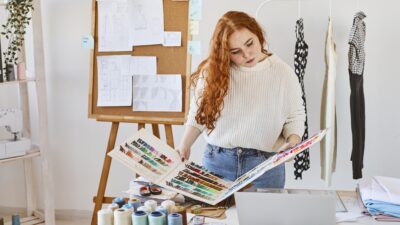Finding your personal style is the foundation of dressing well without putting in excessive effort. Fashion for beginners often starts with self-awareness—understanding what makes you feel confident and comfortable. Begin by assessing your current wardrobe. Identify the pieces you love wearing and consider why they resonate with you. Is it the color, the fit, or the way they make you feel?
Next, take inspiration from various sources such as fashion blogs, social media, or celebrities whose style aligns with your personality. Create a mood board or save images of outfits that catch your eye. This will help you identify patterns, such as a preference for classic, casual, or trendy styles.
Don’t rush this process; personal style evolves over time. It’s okay to experiment with different looks and refine your choices as you discover what works best for you. Remember, the goal is to feel like the best version of yourself, not to imitate others. Keep your lifestyle and daily activities in mind to ensure your style is practical and functional.

Building a wardrobe with versatile staples is key to creating stylish outfits effortlessly. Start by investing in timeless pieces that can be dressed up or down for various occasions. Some essential wardrobe staples for beginners include:
- A well-fitted pair of jeans in a neutral shade like blue or black.
- Classic white and black t-shirts or button-down shirts.
- A versatile blazer for both professional and casual settings.
- Comfortable and stylish sneakers or loafers.
- A little black dress (LBD) for women or a tailored suit for men.
These items form the foundation of your wardrobe and can be mixed and matched with statement pieces to create different looks. When shopping for staples, prioritize quality and durability over trendy designs. High-quality basics not only last longer but also elevate the overall appearance of your outfit.
Additionally, ensure that these staples fit you perfectly. If necessary, have them tailored to suit your body type. Well-fitting clothes make a significant difference in your overall look and help you exude confidence without any extra effort.
Focus on Fit and Comfort
The fit of your clothing is one of the most important aspects of looking polished. Ill-fitting clothes, whether too tight or too loose, can detract from your appearance and make you feel uncomfortable. As a beginner, learning to choose clothes that complement your body shape is essential.
When trying on clothes, pay attention to how they feel and move with your body. Comfort should always be a priority. If you’re unsure about your size, consider getting measured at a store or referring to sizing charts for online shopping. Avoid the temptation to wear oversized clothes for comfort or overly tight clothes to look slim; balance is key.
Remember, certain styles and cuts flatter specific body types. For instance, high-waisted jeans can elongate your legs, while V-neck tops can add a slimming effect to your upper body. Take time to understand what works for you, and don’t shy away from alterations to perfect the fit.
Learn the Art of Mixing and Matching
Mastering the art of mixing and matching allows you to create multiple outfits from a limited wardrobe. This skill is especially useful for beginners who want to dress well without owning an extensive collection of clothes.
Start by selecting a color palette for your wardrobe. Neutral tones like black, white, gray, beige, and navy are easy to pair and work well with brighter or patterned items. Once you have your staples in place, experiment with layering and combining different textures and fabrics. For instance, pair a soft cotton t-shirt with a structured blazer or a flowy skirt with a chunky knit sweater.
Don’t forget to incorporate patterns and prints strategically. Stripes, checks, and subtle florals can add personality to your outfit without overwhelming it. Practice putting together outfits at home, and take photos to refer to later. This will help you identify combinations that work best and save time when dressing up for events or daily activities.
Incorporate Accessories to Elevate Your Look
Accessories are a powerful tool for adding personality and flair to your outfits. For beginners, it’s important to strike a balance between simplicity and creativity. A few well-chosen accessories can transform a basic outfit into a stylish statement.
Start with everyday essentials like a classic watch, a leather belt, or a pair of sunglasses. These items are not only practical but also versatile enough to complement most outfits. For a more personalized touch, consider adding scarves, statement jewelry, or stylish hats to your wardrobe.
When accessorizing, keep the occasion in mind. For example, opt for minimalistic jewelry for professional settings and bolder pieces for social events. Don’t be afraid to experiment—over time, you’ll develop an instinct for what works best with your style.

For beginners, sticking to a neutral color palette can make dressing well much easier. Neutral colors such as black, white, gray, navy, beige, and olive green are versatile and timeless. They serve as the foundation for creating cohesive outfits without requiring much thought.
Neutral tones allow for effortless mixing and matching, giving you more outfit options with fewer pieces. For example, a beige sweater can pair perfectly with black trousers, jeans, or even a patterned skirt. This simplicity ensures you always look polished without overcomplicating your wardrobe.
Once you’ve mastered neutrals, you can gradually incorporate pops of color or bold prints to add variety. For instance, a bright scarf or a pair of colorful shoes can inject personality into an otherwise neutral outfit. By keeping the bulk of your wardrobe neutral, you maintain flexibility while making room for creative styling.
Invest in Quality Over Quantity
When starting out, it’s tempting to buy many items to fill your wardrobe quickly. However, quality should always take precedence over quantity. High-quality pieces may cost more upfront, but they last longer, maintain their appearance, and ultimately save you money in the long run.
Look for well-made garments crafted from durable fabrics like cotton, wool, or denim. Pay attention to stitching, fabric weight, and details like buttons or zippers to ensure you’re getting value for your money. Quality clothing not only feels better but also elevates your overall look, making even simple outfits appear more polished.
Focus on purchasing fewer but more versatile items. Avoid fast fashion trends that may go out of style quickly. Instead, invest in timeless pieces that can transition through seasons and remain relevant for years.
Keep Up with Current Trends Without Overdoing It
Staying updated with current fashion trends can add a modern edge to your wardrobe. However, as a beginner, it’s crucial to approach trends selectively. Incorporate only those trends that align with your personal style and complement your existing wardrobe.
Start by observing trends through fashion magazines, blogs, or social media platforms. Choose one or two elements to try, such as a popular color, accessory, or clothing silhouette. For instance, if wide-leg pants are trending, you could add a pair to your wardrobe while keeping the rest of your outfit simple and classic.
The key is moderation—don’t overhaul your entire wardrobe with fleeting trends. Trends should enhance your style, not overshadow it. A mix of timeless staples and on-trend pieces strikes the perfect balance.
Build a Capsule Wardrobe for Effortless Outfits
A capsule wardrobe is a curated collection of essential pieces that can be combined to create numerous outfits. This approach simplifies dressing, saves time, and ensures you always look put-together.
For beginners, start by identifying 20–30 key items that suit your lifestyle and preferences. Include versatile tops, bottoms, outerwear, and shoes in neutral colors. Add a few statement pieces or accessories to keep things interesting.
For example, a capsule wardrobe could include a white shirt, a denim jacket, black jeans, a neutral blazer, a little black dress, and a pair of comfortable sneakers. With these items, you can create multiple looks suitable for work, casual outings, or formal events.
Organize your capsule wardrobe seasonally, swapping items as needed. This minimalist approach reduces decision fatigue while helping you focus on quality over quantity.
Tips for Dressing Confidently and Naturally
Confidence is the ultimate accessory when it comes to fashion. Dressing well is not just about the clothes you wear but also about how you carry yourself. Here are a few tips to boost your confidence:
- Wear what feels comfortable: Avoid wearing outfits that make you feel self-conscious or uneasy. Comfort translates into confidence.
- Embrace your uniqueness: Your personal style is a reflection of who you are. Don’t feel pressured to conform to others’ expectations.
- Pay attention to grooming: Well-maintained hair, nails, and skin complement your outfits and enhance your overall appearance.
- Stand tall: Good posture can significantly impact how you look and feel in your clothing.
Confidence grows as you become more familiar with your style preferences and learn to dress in a way that highlights your strengths.
Common Fashion Mistakes Beginners Should Avoid
As you embark on your fashion journey, it’s important to steer clear of common pitfalls. Here are a few mistakes to avoid:
- Buying trends blindly: Not every trend suits everyone. Focus on what works for you instead of following every new fad.
- Ignoring fit: Even the most expensive clothing can look unflattering if it doesn’t fit properly.
- Over-accessorizing: Too many accessories can overwhelm an outfit. Opt for a few well-chosen pieces instead.
- Neglecting comfort: If an outfit isn’t comfortable, it’s unlikely you’ll wear it confidently.
- Skipping quality checks: Low-quality items wear out quickly and can make your outfits look less polished.
By avoiding these mistakes, you’ll ensure your journey in fashion for beginners is smooth and rewarding.

Fashion is a journey, not a destination, and every beginner starts somewhere. The key to dressing well without trying too hard is to focus on creating a wardrobe that aligns with your personal style, fits comfortably, and works with your lifestyle. By investing in versatile staples, paying attention to fit and comfort, and incorporating trends and accessories thoughtfully, you can elevate your look effortlessly.
Remember, fashion for beginners is about discovering what makes you feel confident and unique. Take small steps, experiment with different combinations, and learn from each outfit you put together. With time, dressing well will become second nature, and you’ll develop a style that truly represents you.
Start with the basics, stay consistent, and most importantly, enjoy the process. Your fashion journey is as much about self-expression as it is about looking great, so embrace it wholeheartedly!




